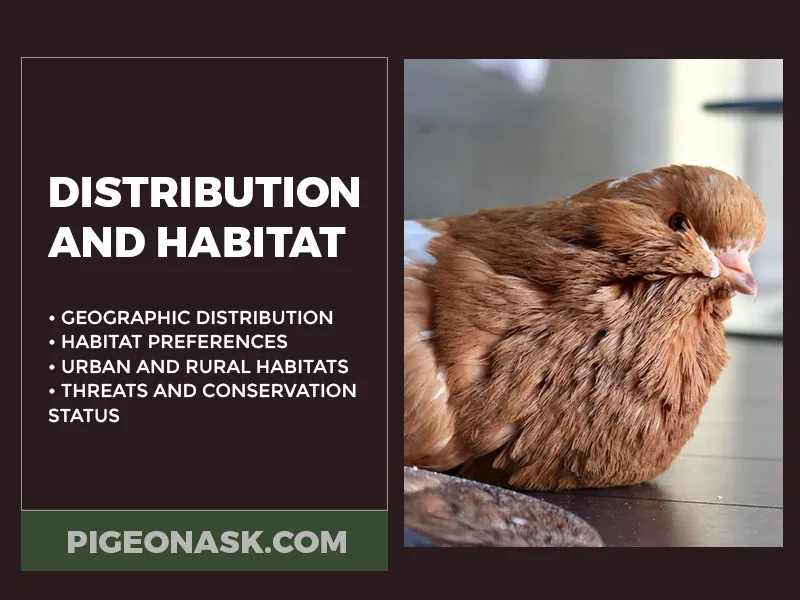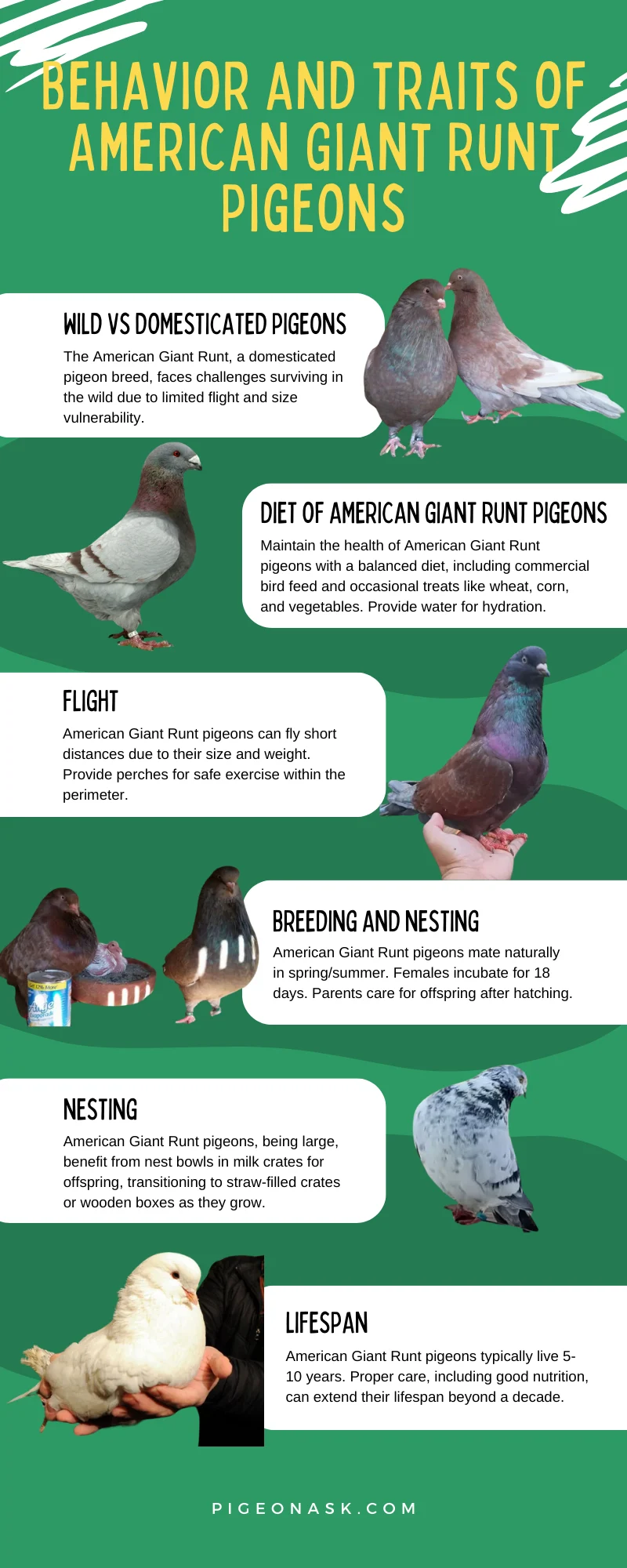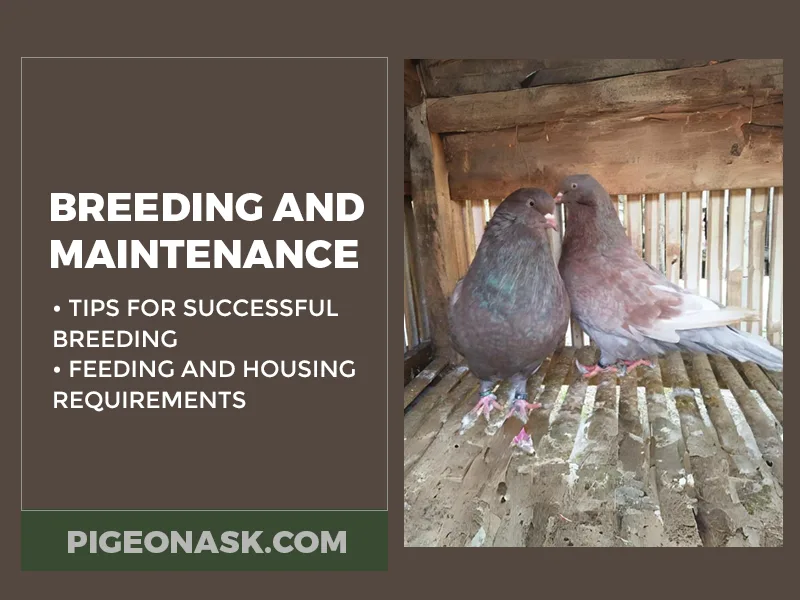American Giant Runt Pigeon Breed Guide
The American giant runt pigeon is a bird developed by selective breeding. It’s one of the largest pigeon breeds worldwide, recognized by the United States and India.
Due to its popularity, knowing how to breed and raise them will come in handy if you’re a pigeon fancier.
That’s what we will do here. In this article, you will find everything there’s to know about the American giant runt pigeon. Also, we will share essential tips to improve your odds of breeding these pigeons successfully.
American Giant Runt Pigeon Profile
| Features Name | Details |
|---|---|
| Scientific Name | Columbia Livia |
| Common Names | American Giant Runt Giant Runt |
| Origin | Italy (Rome) Allegedly |
| Size | Large |
| Weight | 2 to 3 Pounds |
| Lifespan | 5 to 10 Years |
| Physical Features | Large body, thick feathers, different colors, board shoulders, thick beak, medium-sized neck |
| Behavior | Gentle, calm, docile |
| Special Features | Body size larger than most other pigeon breeds |
| Breeding and Maintenance | Easy |
| Common or Popular Varieties | Multiple colors |
Looking for more articles about pigeon breed:
Overview of American Giant Runt Pigeons
The primary purposes for this pigeon breed are utility, exhibition and squab production.
Interestingly, the word “runt” doesn’t have negative connotations with this pigeon breed. Instead, it’s only to describe the pigeons as “common.”
History And Origins of American Giant Runt Pigeons
US fanciers developed the American giant runt pigeon after crossing the original runt with other breeds. The goal was to develop a bulky pigeon with a wide and compact body, creating a majestic bird as a result.
The exact origin of this pigeon breed or its predecessor is not clear.
Nonetheless, one of the first references is available in The Pigeon book, written by Wendel Levi. In this book, the breed first was presented in an exhibition in Philadelphia around 1873.
Physical Characteristics And Features
The giant runt pigeon is one of the most popular birds easily recognizable due to their appearance.

Here’s a breakdown of every physical feature of this pigeon.
| Name | Features |
|---|---|
| Body | Large and stout, with a rounded chest |
| Head | The head of this pigeon is bold and large, featuring an oval shape at the top of the skull. |
| Eyes | Bright eyes. Most have pearl-colored eyes, except for the white variation. This one has bull-colored eyes instead. |
| Beak | Thick and broad. The primary color is black with blue hues. |
| Neck | Medium-sized and gulletless necks, with a broad and full build more noticeable closer to the breast. This area has feathers. |
| Back | Long backs with broad shoulders, with long and thick feathers. |
| Wings | Long wings. Proportional to the body, folded close and wrapped over the rump during flight. |
| Tail | This pigeon has a wedge-shaped tail similar in width to the body and does not drag on the ground during walks. |
Weight
The American giant runt pigeon is a bird that weighs between 2.8 to 3 pounds on average. However, these birds can weigh more than that.
Unique Features
The most intriguing feature of the giant runt pigeon is its size, which is considerably larger and bulkier than other breeds. Also, the green and pink sheen down the neck is another captivating characteristic of this bird.
Other than that, we have to mention the many colors of this pigeon.
Common Variation in Colors
The American giant runt pigeon has evolved in color over the years, developing a variety of colors other than the usual neutral.
Now, the most common are black, white and silver. Still, this pigeon can also be yellow, red, dun, or grizzle.
Distribution And Habitat
Let’s analyze the distribution and habitat of the American giant runt pigeon to understand their living necessities more in-depth.

Geographic Distribution
Currently, the American giant runt pigeon is mostly found in the United States of America. The breed is also popular in India and other countries worldwide, but its presence is most noticeable in the US.
Habitat Preferences
The ideal habitat for the American giant runt pigeon should be warm and cool. These birds can withstand the cold, but extreme temperatures will affect their health.
This is why it’s better to allow the birds to live indoors during these seasons, as they’re not likely to survive in the wild.
Urban and Rural Habitats
This pigeon breed prefers rural and suburban environments to enjoy the open and fly around if they want to.
Also, you may want to avoid breeding the American giant runt pigeon in an urban setting unless there’s enough space for them to live comfortably.
Threats and Conservation Status
The American giant runt pigeon is not a protected breed. Over the years, fanciers have developed a considerable population of this bird and they’re easily available in many areas within the United States.
Behavior And Traits of American Giant Runt Pigeons
This pigeon is calm, gentle and friendly. All these traits make it a suitable bird if you’re looking for a pet.
Nonetheless, the American giant runt pigeon also likes and values its space. For this reason, they prefer to stay away and not interact with humans sometimes.

One way to improve the relationship between humans and this breed is by raising them since they’re young. In this scenario, the birds will develop a closer bond with you.
In any case, this pigeon breed will not cause any behavior issues whether you want it as a pet or for other purposes.
Differences Between Wild and Domesticated Pigeons
The American giant runt pigeon classifies as a domesticated pigeon breed, meaning their survival in the wilderness is less likely. These pigeons can’t fly long distances and their large size makes them vulnerable to predators.
Domesticated American giant runts are more likely to live longer and produce healthier offspring.
Diet
Feed your American giant runt pigeons with a balanced diet to ensure they remain healthy. Serve them with commercial bird feed, which will provide all the nutrients the birds need.
You can complement this diet with other food like seeds but don’t feed them seeds only.
Additionally, you can include wheat, corn and a few vegetables as little treats. Lastly, secure a bowl or recipient with water nearby to help the pigeons hydrate and remain in good condition.
Flight
The American giant runt pigeon can fly, but their size and weight heavily affect their flight skills. They will fly short distances and that’s about it.
Install perches and similar constructions to allow the birds to fly and exercise safely within the perimeter.
Breeding and Nesting
Mating between the male and female American giant runt pigeons is straightforward and doesn’t require accommodations.
The birds prefer to court and mate during spring and summer and the females take approximately 18 days for incubation. After hatching, the parents take care of the offspring.
Nesting
This pigeon breed produces big birds, meaning they may struggle with traditionally small nesting areas. One solution we found is to use a nest bowl inside a milk crate for the offspring.
Then, you can remove the bowl and fill the milk crate with straw when the birds grow.
Wooden nest boxes or larger plastic crates are also good options to build a nest for your American giant runt pigeons. Ultimately, it will depend on how big the birds are and which nesting alternative you see fit.
Lifespan
This pigeon breed can live from 5 to 10 years. If you care for the American giant runt pigeon and keep it well-fed, it may live for more than a decade.
Breeding And Maintenance
The American giant runt pigeon doesn’t require special housing requirements, making it easier to create a comfortable home for them.

With that said, you must keep in mind a few things to guarantee they live a good life and remain healthy. Check out this section to learn more.
Some Tips and Considerations for Successful Breeding
The American giant runt pigeon reaches old age when they’re five years old. So, breed them before to produce healthy and quality offspring.
Some pigeons may have thick feathers that could complicate the breeding process. For this reason, you may need to trim the vent area to facilitate the mating.
Good food, water and sunlight are crucial to ensure the pigeons are healthy and can reproduce without complications.
American giant runt pigeons are decent parents. Still, you should check the eggs and keep an eye on them to guarantee their survival.
Feeding and Housing Requirements
Pens are good housing for the American giant runt pigeon, as these constructions provide shelter and allow them to fly short distances.
You can locate the pen outdoors within a secured perimeter to keep predators away. Also, the birds can live outdoors, but they will need protection during harsh weather conditions.
Other suitable housing for this pigeon breed are cafes or lofts.
After creating the ideal housing, keep the floors clean to prevent illnesses.
Final Word
The American giant runt pigeon is a common but interesting bird due to its background. Fanciers wanted to create a strong bird and they succeeded. Now, we get to enjoy a marvelous pigeon breed for exhibition or even to keep as a pet.
Fascinating, isn’t it? If you liked this article, you can check more of our insightful research related to pigeons and the bird world. Follow us on Facebook, Google News and Twitter and don’t miss out on anything!
